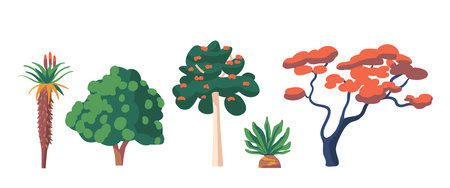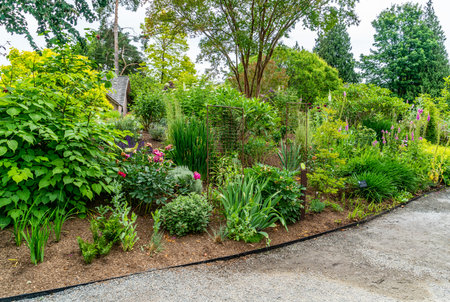1. Understanding Drought-Tolerant Landscaping
If you live in a dry region like the Southwest or deal with seasonal droughts, designing a water-wise landscape is not just smart—it’s essential. Drought-tolerant landscaping, also known as xeriscaping, is all about creating outdoor spaces that use minimal water while staying attractive and functional.
What Is Xeriscaping?
Xeriscaping comes from the Greek word “xeros,” meaning dry. It focuses on using plants that naturally thrive in dry environments, along with techniques that reduce water waste. This approach isnt just for desert areas—its a sustainable option for anyone looking to save water and reduce maintenance costs.
Why Choose Drought-Tolerant Plants?
Drought-tolerant plants require less irrigation, which helps conserve one of our most precious resources: water. These plants are often native or well-adapted to local conditions, making them more resilient to pests and extreme temperatures. Plus, they can add unique textures, colors, and shapes to your yard.
Benefits of Drought-Tolerant Landscaping
| Benefit | Description |
|---|---|
| Water Conservation | Uses significantly less water than traditional lawns or gardens. |
| Lower Maintenance | Reduces mowing, fertilizing, and pest control needs. |
| Cost Savings | Lowers water bills and landscape upkeep expenses over time. |
| Environmental Impact | Supports local ecosystems and reduces runoff pollution. |
Key Principles of Xeriscaping
- Plan Ahead: Start with a landscape design that groups plants by their water needs.
- Improve Soil: Add organic matter if needed to help soil retain moisture without overwatering.
- Select the Right Plants: Use native or drought-resistant species that match your climate zone.
- Efficient Irrigation: Install drip systems or soaker hoses instead of overhead sprinklers.
- Mulch Wisely: Apply mulch to reduce evaporation and keep roots cool.
- Maintain Smartly: Prune, weed, and monitor plant health regularly to keep the landscape thriving.
Xeriscaping doesn’t mean sacrificing beauty—it means rethinking how we use natural resources to create landscapes that are both stylish and sustainable.
2. Choosing the Right Plants for Your Climate
When designing a drought-tolerant landscape, one of the most important steps is selecting plants that naturally thrive in your region with minimal water. Native and climate-adaptive plants are key to creating a sustainable yard that looks great all year round without heavy irrigation.
Why Native and Adaptive Plants Matter
Native plants are those that have evolved in a specific area and are well-suited to the local soil, weather, and wildlife. They typically need less water, fertilizer, and maintenance than non-native species. Adaptive plants arent native but can grow successfully with little care in similar climates. Both types help conserve water while supporting local ecosystems.
Great Plant Options by Region
Here’s a breakdown of plant types that do well in various U.S. regions known for dry or drought-prone conditions:
| Region | Plant Type | Examples |
|---|---|---|
| Southwest (e.g., Arizona, New Mexico) | Succulents & Desert Natives | Agave, Yucca, Red Yucca, Desert Marigold |
| West Coast (e.g., California) | Drought-Tolerant Perennials & Grasses | California Poppy, Lavender, Deer Grass, Toyon |
| Mountain West (e.g., Colorado, Utah) | Cold-Hardy & Low-Water Plants | Sedum, Penstemon, Blue Fescue, Russian Sage |
| Texas & Southern Plains | Heat-Tolerant Natives & Shrubs | Lantana, Salvia greggii, Turk’s Cap, Texas Sage |
Tips for Selecting Drought-Resistant Plants
- Look for plants labeled as “drought-tolerant” or “low water use.”
- Visit local nurseries—they often carry regionally appropriate options.
- Group plants by watering needs to make irrigation more efficient.
Popular Drought-Tolerant Choices Across the U.S.
- Succulents: Aloe vera, Echeveria, Sedum varieties—great for borders or containers.
- Ornamental Grasses: Blue Grama, Fountain Grass—add movement and texture.
- Flowering Perennials: Coneflower, Black-eyed Susan—bring color and attract pollinators.
The right plant choices can make your drought-tolerant landscape not only resilient but also vibrant and full of life. By focusing on native and adaptive species suited to your climate zone, you’ll save water and still enjoy a beautiful yard year-round.

3. Smart Soil Preparation and Mulching Techniques
Creating a drought-tolerant landscape that looks great and thrives with minimal water starts with what’s under your feet—your soil. Preparing your soil properly and using mulch the right way can make a big difference in how much water your plants need, how healthy they stay, and how tidy your garden looks.
Improve Soil Drainage
Most drought-tolerant plants hate soggy roots. That’s why improving drainage is key. Start by testing your soil. Grab a handful of moist soil and squeeze it—if it forms a tight ball, you probably have clay-heavy soil that needs better drainage. Mixing in materials like compost, sand, or perlite can help loosen things up.
Soil Amendment Guide
| Soil Type | Common Issue | Recommended Amendment |
|---|---|---|
| Clay | Poor drainage | Compost, coarse sand, gypsum |
| Sandy | Poor water retention | Organic compost, coconut coir |
| Loamy | Generally good | Add compost to enrich nutrients |
Naturally Enrich Your Soil
A healthy garden starts with nutrient-rich soil. Instead of synthetic fertilizers, go natural with compost, worm castings, or aged manure. These not only feed your plants slowly over time but also improve soil texture and encourage beneficial microbes.
The Power of Mulch
Mulching does more than just make your landscape look neat—it’s essential for conserving moisture and keeping weeds at bay. Organic mulches like bark chips, shredded leaves, or straw break down over time and improve the soil as they do. Inorganic options like gravel or decorative stones work well in modern designs and don’t need replacing as often.
Mulch Comparison Table
| Type of Mulch | Benefits | Best For |
|---|---|---|
| Bark Chips | Retains moisture, suppresses weeds, adds natural look | Traditional or woodland-style gardens |
| Gravel/Rock | Long-lasting, clean appearance, great for drainage | Modern or desert-style landscapes |
| Compost Mulch | Adds nutrients while insulating soil | Vegetable beds or mixed borders |
| Rubber Mulch (recycled) | No decomposition, low maintenance | Play areas or high-traffic zones in xeriscapes |
Create a Polished Look With Purposeful Design Choices
A tidy layer of mulch not only helps your plants but also gives your yard a finished look. Choose mulch colors that complement your home’s exterior or hardscaping elements. You can even edge garden beds with stone or metal borders to keep mulch neatly contained and enhance the overall style of your landscape.
Quick Tips:
- Aim for 2–4 inches of mulch depth to maximize benefits without suffocating plants.
- Keep mulch a few inches away from plant stems or tree trunks to prevent rot.
- Refresh organic mulch annually as it breaks down over time.
- If you live in a windy area, heavier mulches like gravel may stay in place better than lightweight bark.
With the right soil preparation and smart use of mulch, youre setting the stage for a stylish drought-tolerant landscape that thrives naturally and requires less water year-round.
4. Incorporating Hardscape for Style and Function
When designing a drought-tolerant landscape, incorporating hardscape elements is a smart way to reduce water use while boosting both style and functionality. Hardscaping includes non-living features such as stone, gravel, pavers, and decorative structures that help define outdoor spaces and enhance curb appeal without requiring irrigation.
Why Use Hardscape in a Drought-Tolerant Landscape?
- Water Conservation: Hard surfaces don’t need watering, making them ideal for dry climates.
- Low Maintenance: Unlike lawns or flower beds, hardscapes require minimal upkeep.
- Improved Durability: Materials like stone and concrete can withstand harsh weather conditions.
- Aesthetic Appeal: Hardscapes add structure and visual contrast to soft plantings.
Popular Hardscape Materials
| Material | Description | Best Used For |
|---|---|---|
| Decomposed Granite | A fine gravel that compacts well | Pathways, patios, driveways |
| Pavers | Concrete or stone blocks in various shapes | Paved walkways, seating areas |
| Boulders | Larger stones for natural accents | Sculptural focal points, erosion control |
| Drought-Friendly Mulch | Bark or wood chips to retain soil moisture | Around plants, garden beds |
Create Pathways That Guide and Protect
Add charm and structure to your yard with pathways made from flagstone, gravel, or pavers. They help direct foot traffic, protect plant roots from trampling, and reduce the need for lawn space. Curved paths are especially useful in breaking up large open areas while adding visual interest.
Add Decorative Elements with Purpose
You can also introduce decorative hardscape pieces like benches, pergolas, or dry creek beds. These features not only add personality but also serve practical purposes—such as providing shade or directing runoff water away from plantings.
Hardscape Tips for Maximum Impact
- Mimic Natural Forms: Use irregular shapes and materials that blend with your local environment.
- Mood Lighting: Solar-powered path lights increase safety and ambiance without using electricity.
- Cohesive Color Palette: Match stone tones with your home’s exterior for a harmonious look.
The right mix of hardscape elements can transform a plain yard into a stylish and sustainable oasis that thrives even in times of drought.
5. Efficient Irrigation Strategies
When it comes to creating a drought-tolerant landscape, watering wisely is just as important as choosing the right plants. Using efficient irrigation methods not only conserves water but also helps keep your yard looking vibrant and healthy without constant maintenance. Here are some smart strategies to help you get started:
Drip Irrigation Systems
Drip irrigation delivers water directly to the base of each plant, minimizing evaporation and runoff. Its perfect for garden beds, shrubs, and trees where targeted watering is more effective than spraying a large area.
Benefits of Drip Irrigation:
- Reduces water waste
- Prevents overwatering
- Minimizes weed growth by only watering desired plants
- Easy to install and customize for your garden layout
Smart Irrigation Controllers
Smart controllers take the guesswork out of when and how much to water. These devices connect to your Wi-Fi and use real-time weather data to adjust watering schedules automatically.
Why Go Smart?
| Feature | Benefit |
|---|---|
| Weather-based adjustments | Avoids watering during rain or cool temperatures |
| Zone-specific scheduling | Customizes watering based on sun exposure and plant type |
| Mobile app control | Manage your system from anywhere using your phone |
Watering Tips for Drought-Tolerant Landscapes
- Water early in the morning or late in the evening to reduce evaporation.
- Group plants with similar water needs together.
- Use mulch around plants to retain moisture in the soil.
By combining drip systems with smart controllers and following best practices, you can maintain a beautiful, low-maintenance landscape that thrives even during dry spells—all while saving water and reducing utility bills.
6. Maintaining a Stylish, Low-Water Garden Year-Round
Keeping your drought-tolerant landscape looking fresh and lively all year doesn’t have to be complicated. With a few seasonal care tips, smart pruning habits, and thoughtful plant rotation, you can maintain a garden that’s both beautiful and sustainable—no matter the time of year or local water restrictions.
Seasonal Care Tips
Each season brings different needs for your plants. Heres how you can adjust your care routine throughout the year:
| Season | Care Tips |
|---|---|
| Spring | Refresh mulch layers to retain moisture, start light pruning, and fertilize with organic compost to boost growth. |
| Summer | Water deeply but less frequently early in the morning; monitor for pests and signs of heat stress; shade young plants if needed. |
| Fall | Cut back spent blooms, divide overcrowded perennials, and plant cool-season natives or succulents. |
| Winter | Protect sensitive plants from frost with covers or straw mulch; prune deciduous shrubs while dormant. |
Smart Pruning for Healthy Growth
Pruning helps shape your plants and encourages new growth. Use clean, sharp tools and follow the natural form of each plant. Focus on removing dead or damaged branches first, then thin out crowded areas to improve air circulation. For flowering plants, prune right after blooming to avoid cutting off next season’s buds.
Drought-Tolerant Plants That Benefit From Regular Pruning:
- Lavender – trim after flowering to keep compact shape
- Sage – cut back in early spring to encourage bushy growth
Rotate Plants for Visual Interest and Soil Health
If you’re using containers or raised beds in your landscape design, rotating plants seasonally can help prevent soil depletion and refresh the look of your garden. Swap out annuals with seasonal favorites like ornamental grasses in fall or drought-tolerant winter flowers such as pansies and violas.
Ideas for Seasonal Plant Swaps:
| Season | Add These Plants |
|---|---|
| Spring/Summer | Zinnias, Salvia, Echinacea, Blue Fescue |
| Fall/Winter | Pansies, Kale, Dusty Miller, Heuchera (Coral Bells) |
A Little Maintenance Goes a Long Way
You don’t need to spend hours every week to maintain a stunning drought-friendly yard. A monthly check-in to pull weeds, inspect irrigation systems, and remove debris can keep everything looking neat. Stay ahead of seasonal changes by planning a few weeks in advance so your landscape always feels fresh and intentional.
A well-maintained low-water garden doesn’t just survive—it thrives. With a little effort each season, your landscape will stay vibrant, healthy, and stylish all year long.


